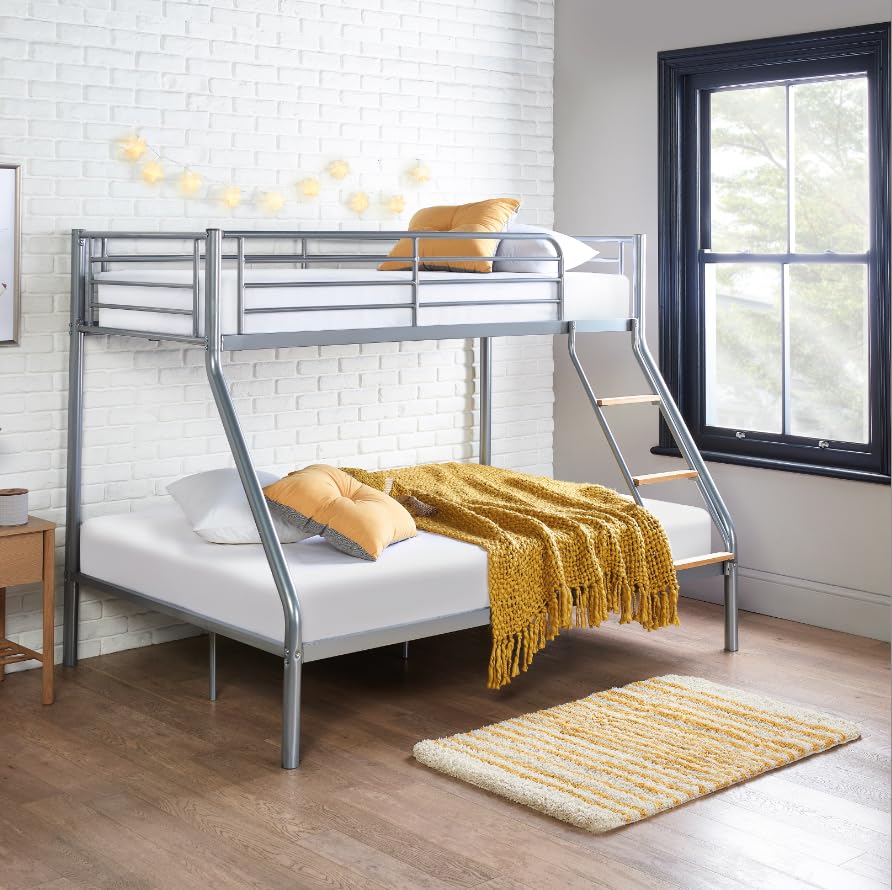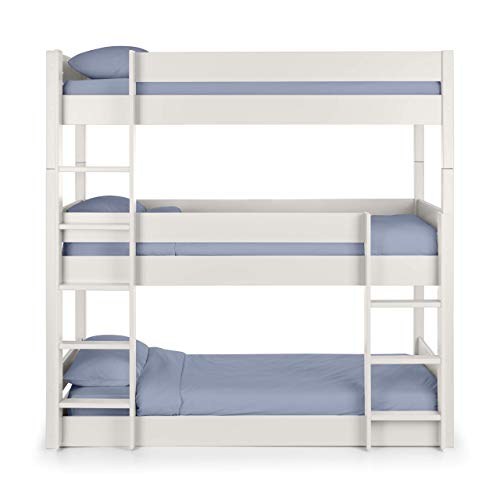3 Bunk Bed’s History History Of 3 Bunk Bed
 Triple Bunk Bed
Triple Bunk Bed
If space is limited, triple bunk beds are a great solution to accommodate multiple sleepers in an efficient way. The best bunk beds are built to last and can withstand three people’s weight at the same time without compromising safety or stability.
Regular inspections of your bunk bed could aid in identifying problems early and extend the life of your bed. Proper cleaning double and single bunk bed care helps keep away water damage or insect infestation, as well as other issues that could affect the structural integrity of the bed.
Benefits
Triple bunk beds are an excellent way to maximize space in a child’s bedroom. Stacking three beds vertically saves space on the floor, making space for furniture and creating an open and clutter-free living space. The stacked design also encourages tidiness since personal belongings can be easily stored in the designated spaces associated with each bed, creating a sense of responsibility and ownership of the space that is yours.
Another benefit of a triple bunk bed is that it can offer more sleeping space than other options which makes it a great choice for households with multiple children or families that often host guests. Based on the design of the triple bunk beds with storage bunk bed there are models with separate twin beds or full-sized beds in the lower level. Some models also have a trundle pull-out bed, providing an extra bed for guests.
They can also be the perfect environment for bonding and sibling relationships, as they allow siblings to share a room, while still maintaining their privacy. The close proximity of beds also encourages a sense of companionship which encourages them to spend more time together playing games, reading or sharing secrets. This sharing ethos also extends to other areas of their lives, positively affecting the quality of their relationship as adults.
In addition to saving space, a triple bunk bed is an ideal option to enhance the look of your home. A majority of them have a stunning wood finish that complements the decor. Some models even come with an integrated staircase that improves the overall look of the room. Some designs include under-bed storage which can be used to store books, toys or bedding.
Whatever style you pick, it’s crucial to take into account safety when purchasing a bunk bed. To ensure stability, make sure that the model you select meets the weight requirements and is constructed of durable materials. Additionally, make sure the bunks are secured with railings on both sides to prevent children from falling off. You should also make sure that the ladder is simple to climb and sturdy enough that your children are able to do it safely.
Design
Triple bunk beds are a fantastic solution for smaller spaces. They are available in a range of sizes, from twin XL to queen, to accommodate children who are growing or guests. They can also be customized with additional features like shelves, desks or under-bed storage drawers to maximize their multifunctionality. This makes them ideal for a range of decor styles, from contemporary to traditional, and fits well in rooms of different dimensions.
The most popular configuration of a three-bunk bed is one that is full-sized on top, and two twins below. This configuration provides ample sleeping space for three people while maximizing floor room for storage and play. A stacked twin over twin design is a fantastic option for siblings who share bedrooms. If you are looking for an even more efficient solution, you could consider a corner triple bunk bed that allows you to make use of the space within the room while offering easy access to both upper bunks that have ladders or a staircase arrangement.
Another option that is popular is a free-standing triple bunk bed that has a ladder to reach the top bunk and an escalator to access the bottom bunk. This kind of bunk bed are ideal for kids’ bedrooms with high ceilings. It gives plenty of headspace but still has the space for dressers, nightstands, and other furniture. This kind of bunk bed can be customised with a slide to make it more enjoyment.
When making a bunk bed stacked, it is important to choose a sturdy and durable construction that can withstand everyday use. Many manufacturers mix plastics, metals, and wood to make their designs. Some even provide a guarantee for long-lasting durability. Metal brackets are used to secure beds to the wall. This prevents warping, and ensures the bed is stable and safety.
It is essential to mark and measure each leg of the triple bed frame to ensure that it fits the mattress correctly. If you’re building a bed with the middle bunk on higher than the bottom, make sure that you cut the 2×2 to a length to fit the leg of the lower bunk. You may need to cut a 2.5 inch square from the corner of each piece of plywood to make it easier for them to fit around the legs.
Materials
A triple bunk bed is a great space-saving solution for a shared kids’ room. It is ideal for smaller families because it is space-saving and eliminates additional furniture. In addition, this type of bed is typically made from durable and strong materials, ensuring that it can hold three kids without the security or comfort.
You can modify a diy triple bunkbed to match your style and space. You can use different colors of paint or wood finishes to add visual interest to the space. Lighting can also add to the ambience of the room. For instance, you could put LED strip lights under the beds, or even fairy lights on the headboards to create a fun look. However, be sure to keep the lighting safely installed and out of reach of children.
To construct a triple bunk bed, first cut the 2×6 boards to the desired lengths. You’ll need a table saw for this job. Once you have the boards cut then sand them down to get an even finish. Then, put them together with wood screws.
For the bottom bunk for the bottom bunk, you’ll need to make two long single and double bed bunk one short side. For the long side, you can use an 71-inch piece, and for the short side, use 39-inch pieces. The difference in size is made up by the width of the 4×4 legs passing through these parts of the frame.
Attach the slats to the frame using pocket hole screws after the frame is erected. Make sure you drill the ends of the slats so that the screw heads are not visible from the bed’s front. Do not forget to glue the slats prior to installing them.
The ladders are to be installed as the final step. You will need 1×2 trims for this. Attach them to the rails of the ladder by using pocket holes, and then fix them to the ladder supports by using brad nails. Be sure to measure the distance between the top of each ladder and the edge of the bottom bunk to ensure it’s identical to the measurement for the top railing.
Safety
Bunk beds are extremely secure when constructed and maintained properly. The risk of a collapse can be mitigated by selecting an option that meets national safety standards, using strong material and durable, and also ensuring that all fittings are secure before use. Bunk bed safety is improved by observing safety guidelines, educating children how to use the ladder in a safe manner and making sure that the area surrounding the bed is free from hazards such as books, toys, and clothing.
It is essential to select a bunk bed with mattress platforms rather than box springs. They are more secure and can support the sleeper’s weight without straining the frame. It is also a good idea for you to check the foundations of your mattress regularly for signs of wear and tear out. If there is a need for a box spring for a bunk bed it is a good idea to use a low-profile foundation that rests on the rails of the bunk bed. This will reduce the chance of head injuries and roll-off accidents.
Make sure that the guardrails on both sides of the bunk are long enough to avoid entrapment. Check the length of the guardrails by trying to insert a wedge block that is standard between the guard rail and the top of the mattress. If the gap is too wide it could result in strangulation. On the side of guardrails closest to the wall the gaps should be small enough that a child’s head cannot pass through.
Children should use only the ladder or stairs to climb onto their bunk beds and not jump onto or climb up on furniture. The ladders should be kept away from light fittings, plug sockets and windows as well as ceiling fans to prevent slipping or falling. It is a great idea to encourage children to sleep on the lower bunk, if they are younger than six years old. This will also stop rough play around or on the bunks.
 Only one person at a given time to sleep on the upper bunk. If the top bunk is used for playing or other activities, it could result in serious injuries if someone falls or hits their head.
Only one person at a given time to sleep on the upper bunk. If the top bunk is used for playing or other activities, it could result in serious injuries if someone falls or hits their head.